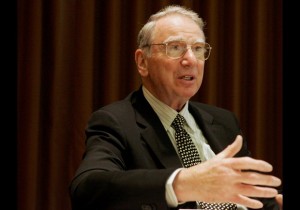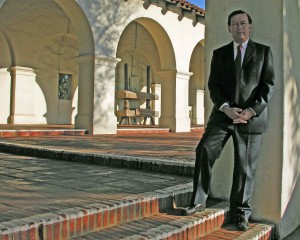Daily Business Report — Jan. 2, 2012
The Battle Over Balboa Park
Irwin Jacobs and SOHO are leading opposing plans to upgrade the park for its 1915 centennial
By Delle Willett
Balboa Park’s plazas were originally designed like the grand plazas of Europe, accommodating pedestrians, automobiles and pigeons. Over the years, however, the park has literally been taken over by cars with nearly 7,000 vehicles driving through the plazas and promenades daily. With 12 million visitors to the park each year, conflicts between pedestrians and vehicles abound.
This problem has long been recognized, and every plan for the park in the past 60 years has had a goal to remove the cars and return the park’s core to people.
With the 2015 Centennial Celebration of the 1915 Panama-California Exhibition in Balboa Park presenting the perfect opportunity, plans have been developed to make the Plaza de Panama a centerpiece for the centennial, removing approximately 54 parking spaces as well as preparing the park for the additional pedestrians and cars that it will require.
The two major plans being considered are The Plaza de Panama Circulation and Parking Project, presented by The Plaza de Panama Committee, a nonprofit entity formed by Dr. Irwin Jacobs, and the SOHO Precise Plan “Lite” that complies with the existing Balboa Park Master Plan and Central Mesa Precise Plan, represented by Save Our Heritage Organisation (SOHO) and a coalition of over 20 groups and organizations.

The Plaza de Panama Project is a permanent plan that involves building a bypass road— the Centennial Bridge—from the Cabrillo Bridge through the Alcazar Garden parking lot and on to a new 785-space, paid-parking, underground garage south of the Spreckles Organ Pavilion, topped with a two-acre park; free accessible tram service from the parking structure to the Plaza de Panama, resurfacing the plaza with contemporary hardscape materials, and adding shade trees, benches and replicas of the original street lights. Overall, the project adds 267 parking spots in the heart of the park and provides for increased disabled parking, a safe drop-off area and valet service.
All told, the project will reclaim 6.3 acres of parks and plazas (the Plaza de Panama, West El Prado, Plaza de California and the Esplanade) for pedestrian use only from what are now roads and surface parking lots, and significantly reduce conflicts between pedestrians and cars. This plan has been vetted by CIVITAS, a landscape and planning firm. The project is estimated to cost $40 million. Approximately $25 million of this cost is for plaza and park improvements, the construction of Centennial Bridge and Road, and improvements to the Alcazar Garden parking lot. The underground parking structure is estimated to cost $15 million.
Financing
The project will be paid for by private donations raised by the Plaza de Panama Committee and a self-supporting bond. No taxpayer funds will be required. The bond will be repaid with revenue generated from parking lot charges. The revenue will also pay for operation and maintenance of the garage and free tram service. A study found that the parking structure would generate enough revenue to support a construction bond, operations and maintenance of the structure, and the operation of the free tram.
The Plaza de Panama Committee has agreed to cover all cost overruns to ensure that there is no risk to taxpayer funds. The Committee will spend over $1,000,000 on the Environmental Information Report (EIR). Leading up to the MOU meeting, Jacobs, co-founder of Qualcomm Inc., has already spent over $2 million on public meetings and planning.
The Plaza de Panama Project must be approved by the San Diego City Council. Leading up to the decision by the City Council, a number of other bodies must provide advisory votes on the project. These include the Balboa Park Committee, the Park and Recreation Board, the Historical Resources Board and the Planning Commission.

It is anticipated that the Draft EIR will be completed and ready for public review and comment January 2012; presented to the City Council in summer 2012; and with all approvals in place, construction started by January 2013 with a scheduled completion date of January 2015.
To date the Committee has participated in roughly 90 meetings with citizen groups, Balboa Park organizations and other stakeholders. Feedback has resulted in positive changes to the project from the first meeting, held more than a year ago. Since then, there have been countless improvements made to the project based on public feedback, and there continue to be.
Alternative Plans
On July 19 the city approved a Memo of Understanding (MOU) with the Plaza de Panama Committee, which served as a contract to continue with the Plaza de Panama plan. At the same time, a number of alternatives to this proposed project are also being thoroughly studied in the EIR. The environmental review process will assess potential impacts of the proposed project and alternatives in the areas of traffic circulation, cultural and historic resources, biological resources, and a number of others. Some people believe as is, the MOU puts the city in the position to go with Jacobs’ plan and precludes them using any alternative.
In response to the memorandum, SOHO sued in San Diego Superior Court to rescind the memorandum claiming the city approved the contract illegally before the completion of a state environmental review. On Dec. 16, Superior Court Judge Judith F. Hayes, in a preliminary ruling, deemed the memorandum illegal for the time being. With final ruling pending, Jacobs declined to comment.
The Plaza de Panama website reports a partial list of backers that includes the majority of Balboa Park institutions, ConVis, San Diego Hotel-Motel Association, Downtown San Diego Partnership, over 900 individuals and businesses.
Representing the public (with over 5000 signatures so far on a petition) and a coalition of over 20 groups and organizations, including The League of Woman Voters, The Committee of 100, Citizens Coordinate for Century 3, SOHO recommends the SOHO Precise Plan “Lite,” an alternative plan that consists of a low-cost, reversible, and phased-design approach for the Plaza de Panama Circulation and Parking Project that complies with the existing Balboa Park Master Plan and Central Mesa Precise Plan. The plan meets the goal of converting the Plaza de Panama to pedestrian use while retaining the maximum degree of flexibility, programmability and access to all, and would allow for managed traffic on the Cabrillo Bridge when appropriate or desired. All of this achieved with the least impact to the park and the National Historic Landmark District.
The SOHO Plan for Circulation is to route two-way vehicular traffic along the southwest corner of the Plaza de Panama, adjacent to the Mingei International Museum, and provide a valet and passenger drop-off on both sides of through traffic. In addition, a new entrance driveway would be provided into the Alcazar Garden parking lot by modifying the existing southern exit road.
SOHO Parking Plan
The SOHO Plan for Parking will replace all 54 current parking spaces in the Plaza de Panama, including the 20 accessible spaces, by creating new public parking spaces in existing parking lots behind park institutions and streets, enabling better and more direct access for visitors and the disabled.
The SOHO alternative plan has no significant adverse effects, and a limited amount of proposed changes, therefore this project could proceed without the need of an EIR. It also has consensus of most of San Diegans, according to Bruce Coons, executive director of SOHO.
“This is a perfect time to try out the plan with the 2015 Centennial. We can see how it works and then adopt it permanently or change it later,” said Coons. “Why do something permanent and unchangeable when we can use a plan that can be changed ?”
The SOHO part of the plan can be accomplished well under $1 million. The potential funding sources: Through the use of a CCDC Redevelopment Tax Increment for funding project sites contiguous to CCDC’s downtown Project Area, the General Fund’s Transient Occupancy Tax (TOT), and the Tourist Marketing District. As a project for the 2015 Centennial could be yet another source of funding.
The principal objections to the Jacobs’/CIVITAS plan include: That the Centennial Bridge and Road will impact the historic nature of the Park that could result in a loss of its National Register District classification and the grant support that comes with this designation. That the bypass bridge would ruin the historic appearance of Cabrillo Bridge. That the plan does not have the public’s support nor the support of the 20-member coalition made up of historical societies, community and neighborhood activists, and preservation and environmental stakeholders.
Plea for a Vote
Coons believes that the Jacobs’ plan should be put to a vote. “If we let the public decide it will end the arguments. San Diego has the right to be ugly as well as it does to be beautiful. If the public votes for this plan then SOHO won’t protest. If this isn’t put to the public vote, people will be shocked when they see how much this changes Balboa Park, and they’ll say ‘Why did you let this happen!’” said Coons.
The preservation of Balboa Park is one of the toughest and biggest preservation fights that San Diego has ever had and it’s garnered more support for SOHO than any other. The two other large ones preservationists fought for and won are Petco Park and the Gaslamp District. “Now people love them; everybody wants to say they fathered them now that they see that they are successful,” said Coons.
The Daily Business Report is produced by REP Publishing Inc., publisher of SD METRO, the North Park News and the West Coast Craftsman. Contact: Manny Cruz (619) 287-1865.


